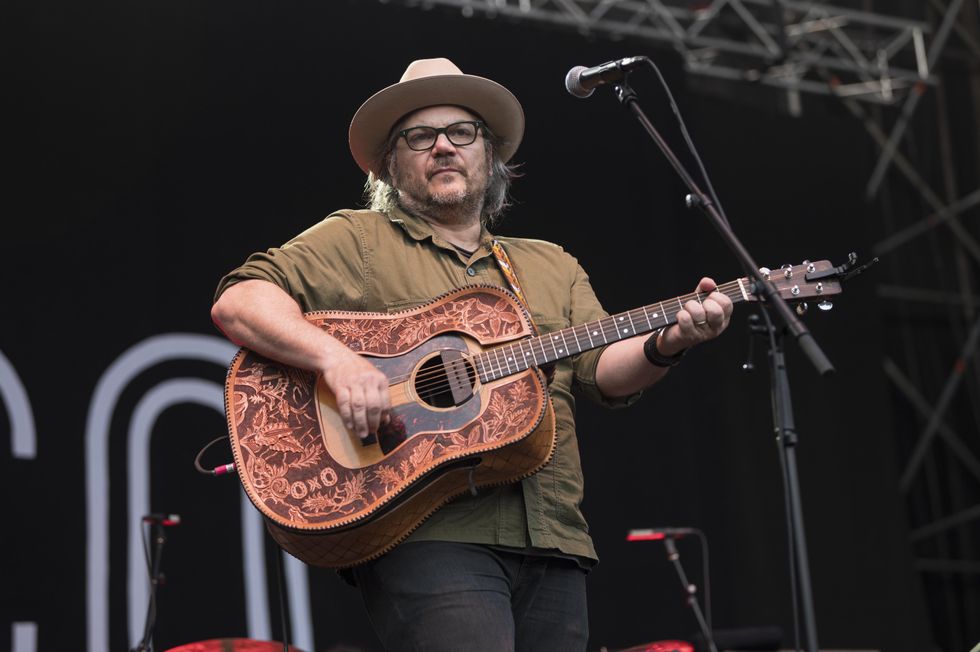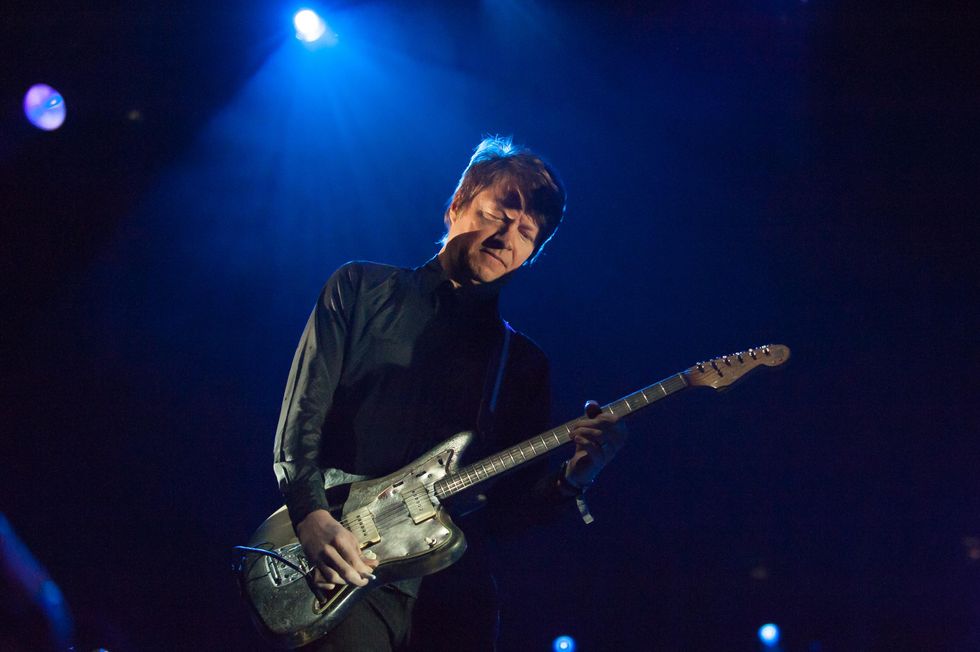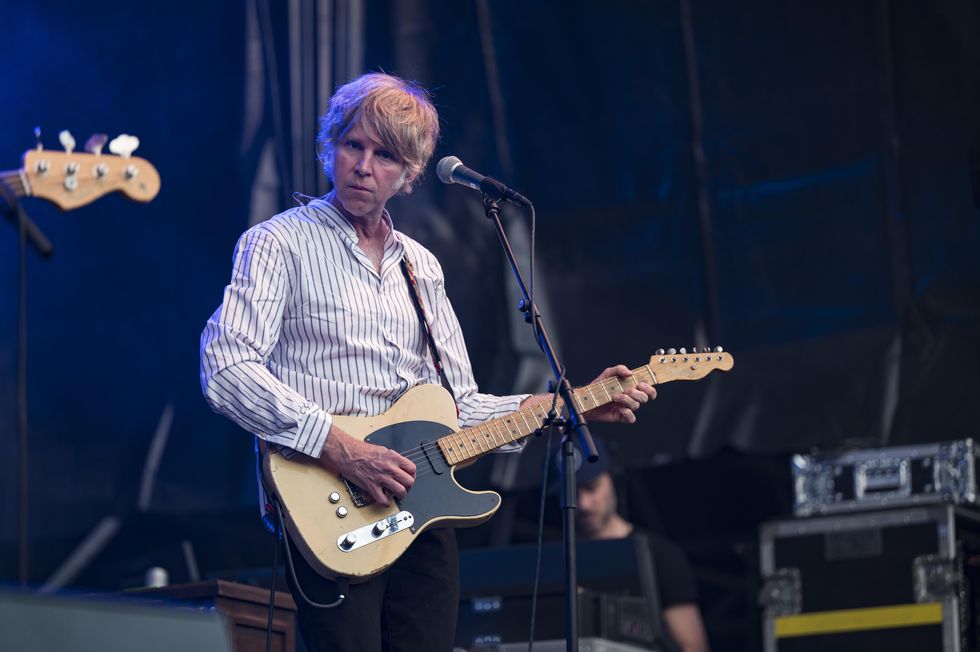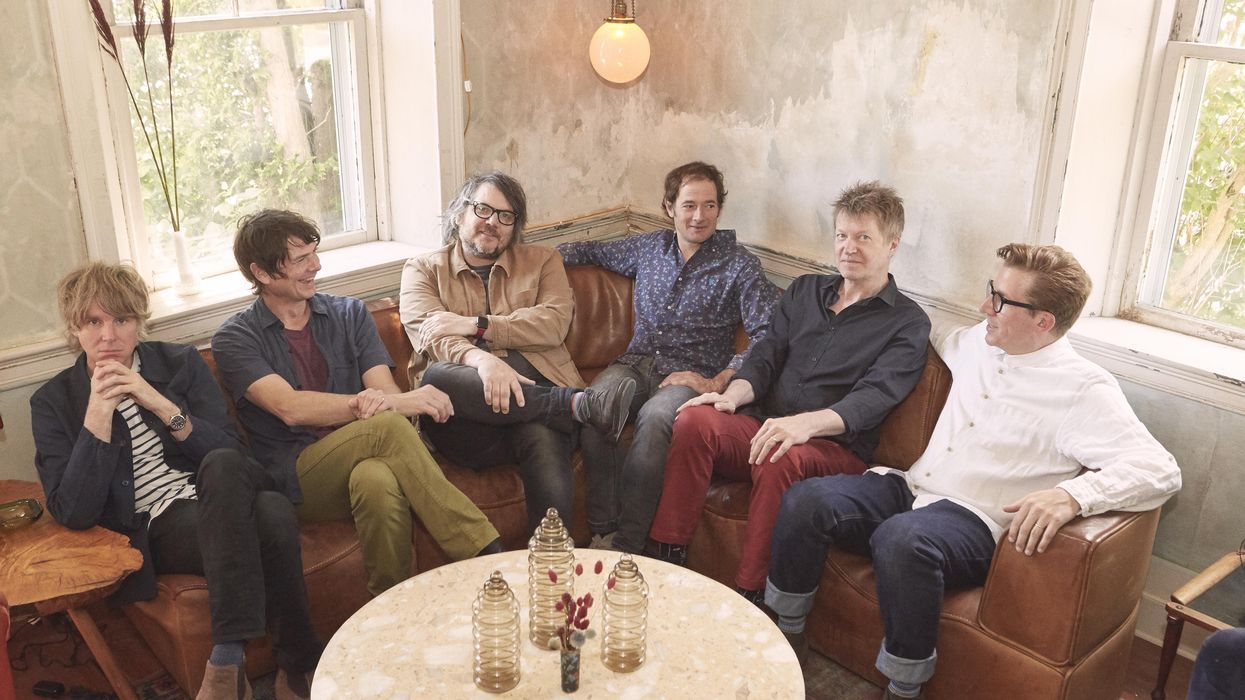Every artist who’s enjoyed some level of fame has had to deal with the parasocial effect—where audiences feel an overly intimate connection to an artist just from listening to their music. It can lead some listeners to believe they even have a personal relationship with the artist. I asked Jeff Tweedy what it feels like to be on the receiving end of that.
“It’s definitely weird having people know you that you don’t know,” he replied. “There’s a level of intimacy that some people feel they’ve had with you because you’ve reached them in intimate moments—your voice has, at least.” But rather than off-putting, he sees beauty in it: “I try to be really respectful of that, ’cause it’s ultimately really sweet. It’s flattering to be a companion to somebody that you don’t know. It’s one of the more beautiful things about doing what I do, in that it has the potential to be difference-making for somebody in a dark moment.”
With the release of Wilco’s 12th studio album, Cruel Country, Tweedy and the band are offering 21 new songs to connect with. And as its title suggests, Wilco sinks into a country vibe more than ever before. Tweedy speculates that fans have always assumed that Wilco is in some way a country band, and although he’s not sure he agrees, he decided to lean into that on Cruel Country.
I Am My Mother
Cruel Country has a concept behind it but isn’t necessarily a concept recording. Tweedy sees it as an “American music album about America.” The songwriter says he’s struggled with what American identity means for decades. “Going back as far as Yankee Hotel Foxtrot, that’s sort of a running theme through a lot of things I’ve written. I would call it an affection or a connection where I can’t really choose. Just like the soft spot you have for your family or the people that you wish knew better but just can’t help themselves, that you have been shown kindness from in other ways. I think that you can be critical of something, believe that its flaws are intolerable, and actually have love for the same person or the same thing. In this case, your country.” Of course, with its twangy riffs, bent-note solos, and other classic sonic signatures, the album can easily be heard as a loving homage to country music. Regardless, this new entry in Wilco’s catalog seems the next right step in the band’s career.
“It all becomes a part of the thing that you can’t fake—ensemble-based playing.”—Jeff Tweedy
The album blends Wilco’s classic sound with that twang and small doses of unconventional arrangements. It refamiliarizes us with Tweedy’s unassuming, mutedly sad, and at times droll lyrics. “Once, just by chance / I made a friend in an ambulance / I was half man, half broken glass,” he sings on “Ambulance.” In the single “Falling Apart (Right Now),” he reflects on the pervasive stress of modern life with the couplet, “Now don’t you lose your mind / While I’m looking for mine.” And in keeping with Wilco’s wilder moments, the band explores abstract effects on the nearly eight-minute “Many Worlds” and ventures into an extended jam for the second half of “Bird Without a Tail/ Base of My Skull.”
Cruel Country started back in 2020, when, after having to cancel a tour with Sleater-Kinney, Tweedy started sending the band songs to work on remotely. They got back on the road in 2021, and during those two years, Tweedy met occasionally with individual members at their Chicago recording and practice space, the Loft, to hash out material. But it wasn’t until January 2022 that all the members were able to meet at the space for the first time since before the pandemic.
Jeff Tweedy’s Gear

Jeff Tweedy used three acoustic guitars on Wilco’s latest, including his faithful Martin D-28. He praises Bob Dylan and Buck Owens as models for his own country-flavored acoustic rhythm playing.
Photo by Jordi Vidal
Guitars
- 1944 Martin D-28 named “Hank”
- 1933 Martin OM-18
- 1931 Martin OM-28
Strings & Picks
- D’Addario Phosphor Bronze EJ16 (.012–.053)
- D’Addario Phosphor Bronze EJ17 (.013–.056)
- Herco Flex 50
- Herco Flex 75
- Snarling Dogs Brain Picks, green, .53 mm
In the days leading up to that, Tweedy was writing more prolifically and continued to forward his rough demos to his bandmates. “The songs started coming very easily and felt very urgent, and it felt good to have a new song to sing each day,” he says.
Guitarist Nels Cline, Wilco’s sonic not-so-secret weapon, notes, “At one point last year, Jeff decided he wanted to send us a song a day that he would record on his smartphone, playing guitar and singing. As I recall, he wrote 51 songs in 52 days. And unlike a lot of his songwriting that we’ve experienced, a lot of these songs had finished lyrics and choruses and everything. Some were so absolutely classic in the style that I would loosely call country songs or folk songs that I didn’t know that they were Wilco songs.”
Multi-instrumentalist Pat Sansone adds, “But when we looked at the material that we had in the works, we saw that we had a lot that was in this style, and decided, ‘Why don’t we lean into these songs to make a body of work?’ I think it’s natural for us to do something like this. It’s always been a part of our vocabulary.”
“I’ve always loved that [B-Bender] sound and I certainly admire the great players. Clarence White was a genius and one of my favorite guitarists. And I’m a big fan of Marty Stuart’s guitar playing.”—Pat Sansone
When Wilco was able to meet, putting together the arrangements for Tweedy’s already fleshed-out ideas came easily. “We actually made the first disc of this record in January in two weeks,” Tweedy says. “And then we got together for two weeks in February and thought initially that we’d just be seeing if we could make anything that would beat the things that are on the first record. We ended up starting to feel like, well, this is kind of making itself a double record. The songs kind of inform each other.” Except for a few overdubs, the album was recorded live—just the six members playing in the studio together. Essentially, the two discs were recorded and released in five months.
When asked what they might have learned about themselves or the band in the making of Cruel Country, all three guitarists say—in some variation—that they discovered Sansone’s skills on the B-Bender Telecaster. “I’ve never seen that before [from him]; it was pretty mind-blowing,” Tweedy laughs.
Cline continues, “A lot of the really twangy, cool-sounding country-style guitar that you hear on this record is Pat. I don’t think he even deigned to add the B-Bender to the record until Jeff asked him at one point, ‘Do you have a B-Bender Telecaster?’ And it was so successful. He’s such a natural at it that Jeff asked him for it again and again on song after song.”
Nels Cline’s Gear

Nels Cline wiggles the vibrato arm on his main guitar, a 1960 Fender Jazzmaster that he’s dubbed “the Watt.”
Photo by Jim Bennett
Guitars
1930s National square-neck resonator
Duesenberg lap steel (with B- and G-Bender levers)
1940s National resonator with Bakelite neck
Early ’50s Epiphone Electar
Mule Resonators “The Mavis” electric resonator
1960 Jazzmaster aka “The Watt”
Neptune 12-string
Fano SP6 by Dennis Fano, with custom-designed Duneland Labs hum-canceling pickups
Amp
- Milkman Creamer with 50W Jupiter 12" speaker
Effects
- Moyo Volume pedal
- Boss CS-3 Compression Sustainer
- Walrus Audio Voyager overdrive
- Vintage MXR Phase 45
- EarthQuaker Devices Disaster Transport delay
- EarthQuaker Devices Aqueduct vibrato
- Big Foot FX Magnavibe
Strings, Picks & Cables
- GHS Boomers (.012 sets; “The Mavis” has flatwounds)
- Dunlop Ultex 1.14 mm
- Bluebird picks borrowed from Pat
- Divine Noise cables
“I’ve always loved that sound,” says Sansone, “and I certainly admire the great players. Clarence White was a genius and one of my favorite guitarists. And I’m a big fan of Marty Stuart’s guitar playing. It’s something that I learned that I really like to play, and it’s something that I definitely want to get better at.”
Of all the songs on the record, Sansone names “Mystery Binds,” a dreamy folk-rock ballad with plenty of texture, as one of his favorites. “That’s the song that Jeff had sent to us in the dark days of the pandemic when we were still working remotely. I immediately took to that song. I thought it had a really unique and beautiful mood and was something a bit different than anything I’d heard Jeff send us. ‘Many Worlds’ is another favorite. That was Nels and I playing together and kind of playing off each other, and that’s always a thrill—to be able to do that with him.”
Cline and Sansone say that “Many Worlds,” despite how kaleidoscopic its sonic architecture might seem given the abundance of effects and instrumentation, was recorded live like the rest of the album. Sansone actually got up in the middle of the song to switch from piano to guitar. “[We wanted to] see if we could play it live,” Tweedy shares. “We tried it, and you can hear us moving around on the track. But it all becomes a part of the thing that you can’t fake—ensemble-based playing.”
“One friend of my wife’s and mine who’s French once compared my lead guitar playing to the voice of Edith Piaf.”—Nels Cline
The three guitarists in the band have found their own ways to complement each other. Cline is often thought of as the lead guitarist, with Sansone typically alternating between back-up guitar and keys. Tweedy sets the tone at the front, either with rhythm strumming or fingerpicking. On Cruel Country, however, Cline comments that Sansone took the role of lead guitar on many songs with his B-Bender, and Tweedy says that his primary goal was to be a solid country strummer.
“One person I think is really good at that, oddly enough, is Bob Dylan. I like the drive that he has on his records when he’s playing acoustic guitar,” Tweedy opines. “I like Buck Owens and country recordings where it’s not even a specific player—it’s just a style of playing where the guitar becomes part of the rhythm section, almost like a tambourine or something.” The guitars Tweedy used on the album were all Martins, including his 1944 D-28, 1933 OM-18, and 1931 OM-28.
The axes Cline played on the album include a 1930s National square-neck resonator, a Duesenberg lap steel, a Neptune electric 12-string, and his main guitar, the 1960 Jazzmaster known as “the Watt.” Cline, whose background includes experimental and avant-garde jazz, names Electric Ladyland by the Jimi Hendrix Experience, Meditations by John Coltrane, and Solstice by Ralph Towner as three of his top albums. He also mentions that since age 10 he’s been fascinated and inspired by Indian classical music, and that among his many, many influences on the guitar is Peter Frampton—one he says journalists tend to leave out.
Pat Sansone’s Gear

Pat Sansone’s B-Bender-equipped Telecaster became an essential part of the new Wilco record, helping to put the steel-guitar sound of country into the new Cruel Country.
Photo by Jordi Vidal
Guitars
Tokai Telecaster with B-Bender
1963 Epiphone Casino
1988 Rickenbacker Roger McGuinn 370/12 12-string
Amp
- Vintage Fender Deluxe
Effects
- ’70s Ibanez Phase Tone II
Strings, Picks & Cables
- Assorted D’Addario sets
- Bluebird picks (made from 1930s Argentinian poker chips by Pat’s brother-in-law)
- Divine Noise cables
Cline describes himself as versatile and isn’t sure his jazz roots influence what he records with Wilco. “I try to change what I play based on what I think the song is asking for, or quite often what Jeff specifically asked for. I don’t know that I have any voice that I could zero in on. I’m many voices. One friend of my wife’s and mine who’s French once compared my lead guitar playing to the voice of Edith Piaf. I think it’s because of what I call the wiggle—my fast vibrato which is inspired by John Cipollina from Quicksilver Messenger Service and Tom Verlaine from Television.”
Sansone—whose favorite albums include Revolver, Odessey and Oracleby the Zombies, and Third/Sister Lovers by Big Star—describes his approach: “I have a tendency to go toward melodic figures, finding places where counter-melodies can support the arrangement, or melodic bits on the guitar that help connect different parts of the song. That’s probably where my style and my sensibilities are maybe most unique in the group.” The B-Bender-equipped instrument he used on the album was a Tokai Telecaster. He also played a 1963 Epiphone Casino and a 1988 reissue Roger McGuinn 12-string Rickenbacker. In the studio, he prefers using a Swart Atomic Space Tone amp. “It’s just a small amp, low voltage, one 10" speaker, but it has a beautiful tone. It takes pedals very well, so it’s easy to get a range of tones at low volume.”
Wilco’s songs have always begun with Tweedy. He has some methods of writing that help him along the path of fine-tuning his work, including sharing his ideas with the band. “When I play my songs for the rest of the band, I start to hear them with other people’s ears. It kind of provides at least a little moment of objectivity, ’cause I can hear ’em and forget that I made them up,” he shares. His songwriting is defined by the simple notion that he can’t not be himself while composing. “And at some point, you try to be yourself on purpose,” he elaborates. “I can’t really extract myself from it anymore. It’s just a thing that I do, and it results in a thing that has some ‘me-ness’ to it. Like some ‘Jeff-ness.’
“When I play my songs for the rest of the band, I start to hear them with other people’s ears.”—Jeff Tweedy
“I like reading a lot, I like listening to records, and I generally do both until I can’t take it anymore and I feel like I need to do something of my own,” he continues. “I need to answer that call to add my own voice to the [mix]. It’s just inspiring when you spend time with other people’s consciousnesses.”
In the nearly 40 years he’s been performing as a professional recording artist, Tweedy’s ambitions haven’t really changed. “All the decisions I feel have been mostly centered around, ‘What path do we take that will allow us to do this tomorrow?’ I mean, first, if you can’t picture it, it can’t happen. Even ‘I want to be a songwriter,’ to me, is a little bit more intangible than ‘I want to write a song.’ That’s a manageable goal, and all your big dreams are built on those manageable goals. Because if you don’t do those, other things don’t happen.”
YouTube It
Pat Sansone lays down some heavy twang with his Fender Telecaster in this three-guitar-frontline performance of “Falling Apart (Right Now),” from Wilco’s new Cruel Country, at the band’s Solid Sound festival 2022 in North Adams, Massachusetts.






















![Rig Rundown: AFI [2025]](https://www.premierguitar.com/media-library/youtube.jpg?id=62064741&width=1245&height=700&quality=70&coordinates=0%2C0%2C0%2C0)




















 Zach loves his Sovtek Mig 60 head, which he plays through a cab he built himself at a pipe-organ shop in Denver. Every glue joint is lined with thin leather for maximum air tightness, and it’s stocked with Celestion G12M Greenback speakers.
Zach loves his Sovtek Mig 60 head, which he plays through a cab he built himself at a pipe-organ shop in Denver. Every glue joint is lined with thin leather for maximum air tightness, and it’s stocked with Celestion G12M Greenback speakers.












![Devon Eisenbarger [Katy Perry] Rig Rundown](https://www.premierguitar.com/media-library/youtube.jpg?id=61774583&width=1245&height=700&quality=70&coordinates=0%2C0%2C0%2C0)






